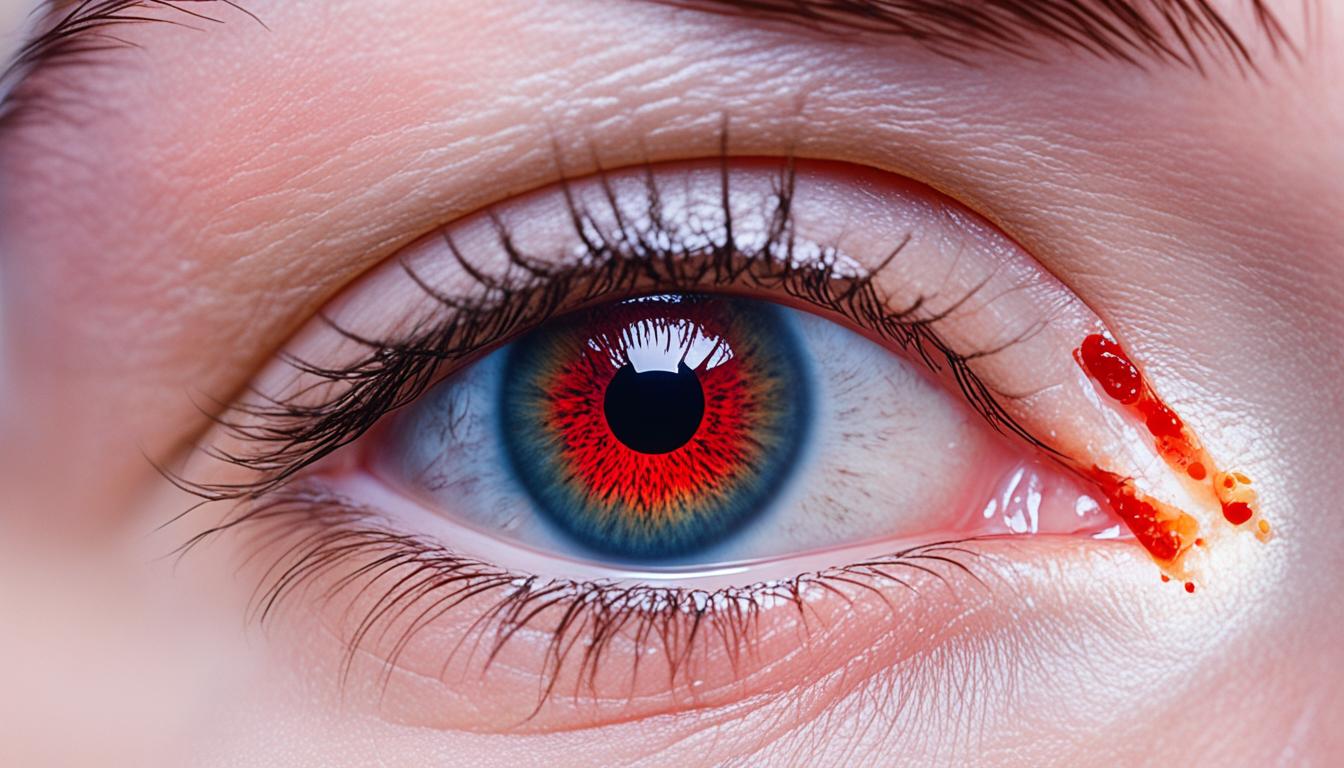A stye, or hordeolum, is a red bump on the edge of the eyelids. It’s tender and caused by a blocked oil gland. This usually happens at the base of the eyelashes. Styes might also form internally or under the eyelid. They make the eye red, sore, and itchy. Known causes include bacterial infection. Risks for getting styes are wearing contact lenses, old or dirty eye makeup, and certain health conditions like diabetes.
Home remedies can help treat styes. Use warm compresses, keep your eyes clean, and don’t touch the area or wear makeup. Over-the-counter pain meds can also ease the discomfort. If a stye doesn’t go away or is very painful, see a doctor. They might use special cleaners, antibiotic eye drops, steroids, or make a small cut to drain it. To stop styes from coming back, wash your hands and face often. Limit using eye makeup and regularly use warm compresses.
Key Takeaways:
- A stye, or hordeolum, is a tender, red bump on the edge of the eyelids caused by a blocked oil gland.
- Symptoms of a stye include redness, tenderness, swelling, eye soreness, and itchiness.
- Bacterial infection, poor eye hygiene, and certain underlying conditions increase the risk of developing styes.
- Treatment for styes includes applying warm compresses, practicing good eye hygiene, and taking over-the-counter pain medications.
- Severe or persistent cases may require medical intervention, such as antiseptic cleansers, antibiotic eye drops, or surgical incisions.
- Preventing styes involves maintaining good skin hygiene, washing hands regularly, minimizing the use of eye makeup, and applying warm compresses.
Stye vs. Pink Eye: What’s the Difference?
Pink eye, or conjunctivitis, is an infection or inflammation around the eye’s white part and inner eyelid. It can come from allergens, irritants, viruses, or bacteria. Symptoms include redness, swelling, more tears, itching, discharge, and crusty eyelids.
A stye is an infection in the tear duct that makes oil. It shows up as a red, painful bump on the eyelid’s edge. You might also have swelling, itchiness, soreness, crusts on the eyelid, sensitivity to light, and more tears.
Pink eye and styes, though both annoying, have different causes and treatments. Pink eye often needs medicines, either antiviral or antibiotics. Styes, however, can sometimes get better with just warm compresses. But, sometimes, the doctor’s help might be needed, especially if the problem doesn’t go away.
Comparing Pink Eye and Stye Symptoms
| Pink Eye (Conjunctivitis) | Stye |
|---|---|
| Redness | Painful red bump on the edge of the eyelid |
| Swelling of the conjunctiva | Swelling |
| Increased tear production | Soreness |
| Itching | Itching |
| Discharge | Crusting around the eyelid |
| Crusty eyelids | Sensitivity to light |
To sum up, telling pink eye from a stye is crucial for the right treatment. Though they both make your eyes hurt and look bad, each needs its own care. If you have any of these symptoms, talking to a doctor is the best step. They can give you a plan that’s just for you.
Prevention and Treatment of Styes and Pink Eye
For styes, using warm compresses several times a day can help ease the pain. But there’s more you can do. To avoid styes and pink eye, good eye and hand hygiene is key. Wash your hands and face often. Stay away from the area and don’t use makeup. Over-the-counter pain meds might also reduce discomfort.
Don’t wait if a stye doesn’t get better or gets worse in a few days. It’s important to get help from a doctor. They can use special soaps, antibiotic eye drops, steroids, or even do a small surgery. Preventing styes means keeping your eyelids clean, taking off makeup before sleep, regular hand washing, not touching your face, and using warm compresses for healthy oil glands.
Pink eye’s treatment depends on what caused it. Viral pink eye usually gets better on its own in a week or two. Bacterial pink eye might need antibiotic drops. For pink eye from allergies or irritants, remove the cause and take antihistamines or use special eye drops. Avoiding pink eye means washing hands well, not sharing eye stuff or towels, not using contacts when infected, and staying away from things you’re allergic to. If pink eye gets worse, messes with your vision, or causes a lot of pain, see a doctor right away.

